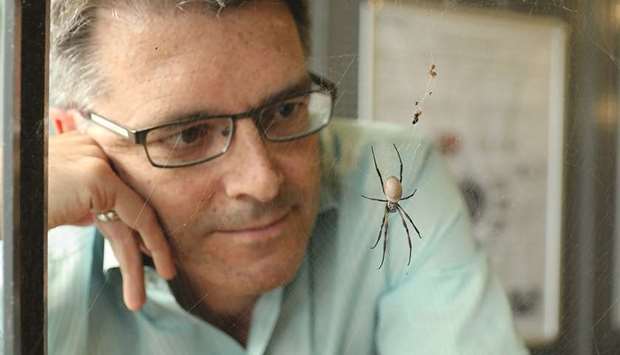Spiders’ webs aren’t something most people like to see in their houses – after all, they’re a sign of less than spotless cleaning.
But for materials scientists at the University of Bayreuth in Germany, as well as many of their counterparts worldwide, spider silk is exciting stuff, with applications as varied as cardiac tissue engineering, breast implant coatings and even biodegradable running shoes.
Thomas Scheibel, a professor of biomaterials at the University of Bayreuth’s Department of Engineering, has teamed up with Dr Felix Engel, a professor of experimental renal and cardiovascular research at Germany’s Erlangen University Hospital, to show how spider silk could be used to help restore cardiac muscle cells lost in a heart attack.
Actually, they are using an artificial silk protein developed in the laboratory. Called fibroin, it’s what gives the spider silk its structure and mechanical stability.
Engel has previously demonstrated that fibroin from an Indian silkworm is especially suitable as scaffolding material for engineering cardiac tissue.
Producing the silk protein in sufficient quantities of consistent quality has proved impossible, though – until recently, that is. “We succeeded in producing a recombinant silk protein from the European garden spider,” Scheibel says.
Intensive research is being done on many materials with potential for tissue engineering, points out Dr Wolfram-Hubertus Zimmermann, spokesman for the German Centre for Cardiovascular Research (DZHK) at Goettingen University Medical Centre. He calls the work by Scheibel and Engel “a very early stage” of a development whose outcome is still unclear.
What’s new in their approach, he says, is the production of the silk outside the spider’s body.
Spider silk is more resilient than nylon, Kevlar and all other known fibres. Attempts to harness it as a material go back to the 1980s, but major chemical companies have been unable to produce large quantities of it.
“Everybody said at the time that it couldn’t be done,” Scheibel recalls.
Breeding spiders in large numbers and milking them for their silk isn’t economical, he adds. And there’s a drop-off in the silk’s quality when spiders are in captivity.
Since the proteins in spider silk are what give it its mechanical properties, producing the proteins in large quantities is sufficient. However, spider silk proteins are composed in a way that makes them congregate into extremely firm structures upon merely slight external impact.
“This is essential in the natural silk spinning process, but tends to be a hindrance to stirring and purification,” Scheibel says.
In 2008, Scheibel, then at the Technical University of Munich, founded the company AMSilk with two of his colleagues. It took the start-up, located near Munich, three years to produce a protein from the dragline silk of the European garden spider in a 120,000-litre fermentation vessel.
The scientists had to manipulate the proteins via so-called recombinant technology as well as develop a special purification and spinning process.
They created a white fibre that hardly looks any different from other fibre types, including synthetic polymers. But because the material is organic, it has the big advantage of being recyclable.
“In the wild, spiders eat their webs,” Scheibel notes.
Another property that makes spider silk attractive to the medical profession is its sterility. “Spider silk is naturally so durable because it’s bacteriostatic,” Scheibel says. Bacteria and fungi can’t adhere to its surface.
As far back as ancient Greece and Rome, spiders’ webs were used as wound dressings.
Scientists at the University of Bayreuth have found a way to coat silicone breast implants with spider silk proteins to lower the risk of inflammation and rejection by the body.
As Dr Philip Zeplin, a plastic and cosmetic surgeon at Germany’s Ludwigsburg Institute of Plastic Surgery, points out: “Silicone isn’t accepted very well by the body.”
About 10 per cent of healthy women who receive untreated silicone implants for breast augmentation develop what’s known as capsular contracture: Internal scar tissue forms a capsule around the breast implant, contracting it until it becomes misshapen and hard. The figure is 26 per cent for breast cancer patients who have had radiation treatment.
Tests of the spider silk “bioshield” on animals have been successful, and tests on humans are to begin soon.
“I’m very confident that the silk proteins will prove themselves,” says Zeplin, adding that he believes they will also be suitable for other implants such as coronary stents, dialysis catheters and artificial heart valves.
Businesses, too, are showing an interest in spider silk. Sports apparel manufacturer Adidas, for example, has developed a prototype running shoe made of biodegradable synthetic spider silk.
In fact, spider silk was once valued as a clothing fabric. In the 19th century, naturally gold-coloured garments were woven from the silk of golden orb weaver spiders. Louis XIV of France, known as the Sun King, is said to have had gloves made of spider silk.
Fashion is all very well, but what about durability?
“Spiders’ webs last forever,” notes Scheibel. You can find some in old buildings that have been around for 500 years, he says. - DPA

Thomas Scheibel, a professor of biomaterials at the University of Bayreuth’s Department of Engineering, is working on a project to show how spider silk could be used to help restore cardiac muscle cells lost in a heart attack.
